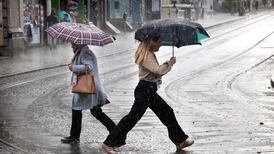A sun-tanned, white-haired, 81-year-old woman who has devoted her life to preserving the animal kingdom may well be the most impressive person to have come to Paris for the COP21 UN climate conference.
The draft accord, which should be finalised on Saturday, merely notes “the importance of ensuring . . . the protection of biodiversity”. But Jane Goodall, the British primatologist who is the world’s leading expert on chimpanzees, says the agreement is crucial to their survival.
“There used to be more than a million chimpanzees in the world; there are only 300,000 left,” Goodall says. “The main threat to chimpanzees is deforestation, which destroys their habitat. The second is the live meat trade, and sadly there’s a growing trade in live animals, where the mothers are shot and the babies are taken for sale.”
Sustainable management
Deforestation is a major cause of climate change, as the carbon dioxide in trees is released into the atmosphere when they are cut down and burned.
Article 3 of the draft accord encourages parties to the UN convention on climate change to “conserve and enhance” forests as “sinks and reservoirs” of greenhouse gases. The draft accord mentions the need to reduce deforestation and forest degradation, and to achieve “sustainable management of forests” in three separate sections.
“Climate change affects us, of course, but it’s affecting all the other animals too,“ Goodall says. “We are so arrogant to think that this one form of life, that is so horribly destructive, is more important than everything else.”
Goodall worked as a waitress to pay her fare to Kenya when she was 23 years old. Her mentor, Kenyan anthropologist Louis Leakey, sent her to Cambridge to earn a doctorate in ethology (animal behaviour). Today, she holds honorary doctorates from more than 45 universities.
Goodall’s reverence for animals contrasts with the attitude of some leaders at COP21. US secretary of state John Kerry said in a speech last month that the threat from global warming was not just the “harm that is caused to the habitat for butterflies or polar bears as some people try to mock it . . . Climate change is not just about Bambi.”
Goodall reminds us that the butterflies, polar bears and Bambi are important. In its most recent Living Planet Report, the World Wildlife Fund reported that between 1970 and 2010, populations of mammals, birds, reptiles, amphibians and fish around the world dropped 52 per cent.
“People don’t realise the ripple effect,” Goodall says. “A small insect that disappears may be the main food of a certain fish, which may be the main food for a certain bird. There are examples where it has led to ecosystem collapse just because one link is taken out of the food chain.
“In the rainforest, you learn about the interdependence of all life. I think we made a mistake calling it bio-diversity . . . If you talk about the web of life, people understand.”
Azzedine Downes, head of the International Fund for Animal Welfare and elephant expert, shared a stage with Goodall at a seminar.
“There hasn’t been a lot of discussion about the impact of climate change on animals at COP21,” he said.
Drought
There were only 350,000 elephants left in the wild and 33,000 were being killed every year, Downes said.
Climate change forces animals to migrate, as humans do. Drought in east Africa has forced elephants to become more nocturnal, to hide from the sun.
“Many elephants leave dry areas and move towards wetter areas. That’s a trap, because those are the countries where poaching is out of control.”
Stanford academic Ken Caldeira, who is cited by Elizabeth Kolbert in The Sixth Extinction, says that animals would have to migrate poleward by 30 feet a day to keep pace with present temperature changes.
Goodall spent decades on the Gombe reserve in Tanzania observing how much our closest cousins resemble humans. She discovered that chimpanzees make and use tools, for example to “fish“ edible termites from a mound.
Louis Leakey wrote that, thanks to Goodall’s research: “We must now redefine man, redefine tool, or accept chimpanzees as human.”
Goodall also discovered that chimpanzees, like humans, can be aggressive and violent.
“When rainforests start shrinking, they will become more territorial and brutal,” she says. “If a community is forced to move, they cannot just blend in with another community. There will be pitched battles.”
As a child in southern England, Goodall says, her pet dog taught her “there’s no sharp line dividing us from the rest of the animal kingdom”. Chimpanzees hug, kiss, pat each other on the back and even tickle each other.
Goodall describes the rescue of a female chimpanzee in 2013 as "the most amazing interaction I've ever had . . . when we released this adult female from her travelling cage onto the island. She turned and embraced me." The clip can be found on YouTube. "She was a chimp we rescued from the bush meat trade. Her name was Wounda, which means 'close to death'."
Goodall, a vegetarian, says carnivores “are going to have to change. Because in order to feed the billions of animals that are being raised for us to eat around the world, huge areas of rainforest are cleared to grow grain to feed them.”
Social media
Farm animals produce methane, a more virulent greenhouse gas than carbon dioxide. Methane was not discussed at COP21, nor did negotiators suggest people should eat less meat.
Goodall spends 300 days a year on the road, campaigning for better conditions for farm and wild animals. The Jane Goodall Institute has 19 offices around the world, and its youth programme, Roots & Shoots, has 100,000 groups in 140 countries.
Goodall admires Pope Francis and advocates the power of social media to denounce enemies of the environment.
“Young people energise me,“ she says. “As long as I have health, strength and the ability to communicate, I‘ll keep fighting.”











